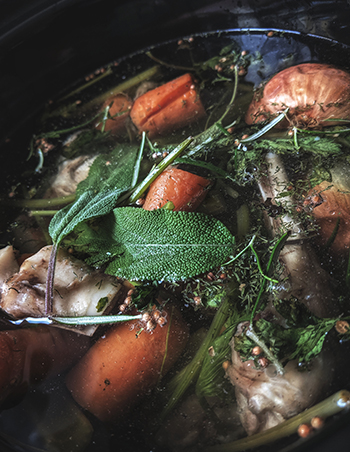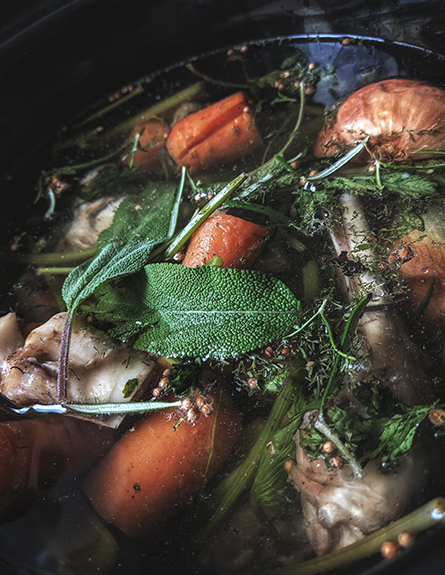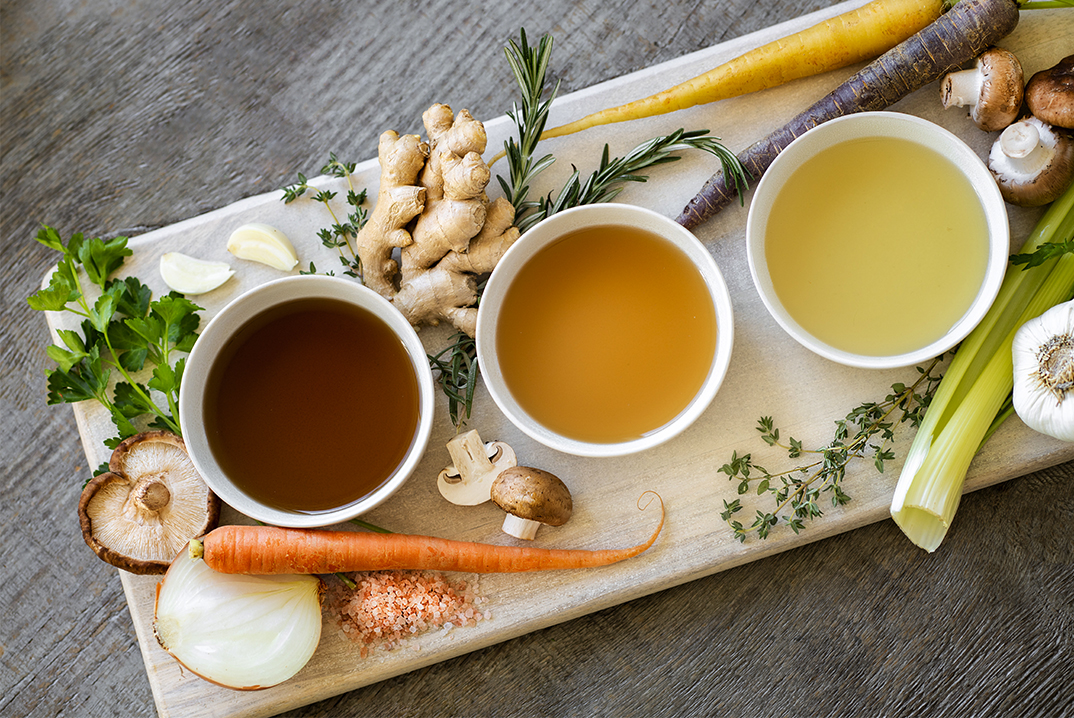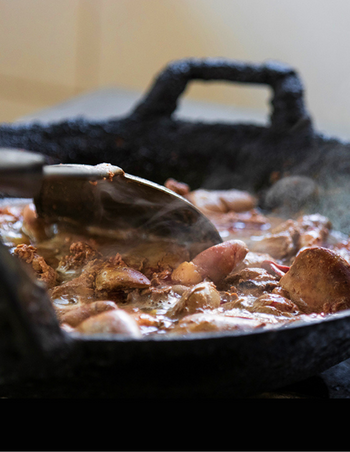
Why Bone Broth is the Perfect Supportive Superfood this Fall
Date: 11/08/2023
Warm up your diet this autumn and get cozy with a cup of bone broth for tons of awesome nutritional benefits!
There’s a moment each year, right at the height of autumn, when I suddenly get a very strong feeling to make all the soups. I don’t know if it’s my human ancestors telling me to stay strong, or just my body wanting to stay warm, but throwing together tons of excellent veggies, meats, and other good stuff into a thick stew is my favorite way to start my transition into winter.
As soup-season approaches then, I thought I would check out some new recipes to try…only to stumble across a newly ‘trending’ super-food: bone broth! And while bone broth has been around since humans learned to boil water, I was only recently hooked by the idea of using it as a staple for this season’s round of soup-making.
So what was it that got my attention?
Well, as you know, I’m becoming more and more a deep advocate for taking a proactive approach to our health and well-being, especially through practices such as bio-hacking. I believe we can take simple, small steps in our day-to-day routines that can provide a great foundation for good health, and which can help our bodies better process any undesirable symptoms, viruses, or diseases that come our way.
When I then learned that bone broths are a fair source of essential vitamins, minerals, and amino acids that help boost gut and digestive health; strengthen joints, bones, and skin; and even boost our immune system, I couldn’t ignore this incredible opportunity to support my own health by adding bone broth to my regular diet this winter.
I don’t want you to ignore the opportunity either! That’s why today I want to share with you a little more about what I discovered in my research about bone broth, how to make bone broth, as well as some awesome bone broth uses you can incorporate into your meal rotation this season!
What is bone broth?
What is bone broth? Simple! It’s a clear soup base or ‘broth’ that is made from boiling animal bones and other connective tissues and/or meats. After many hours of boiling, a savory, hearty broth is the result–and the longer you simmer, the more concentrated the nutrients will be in that broth! That’s why a lot of people will say this is the best way to use those parts of the animal that you can’t eat – but which are still densely packed with good nutrients your body needs.
“But that’s just soup stock, isn’t it?”
Well, not exactly.
Sure, they’re both made by simmering bones and veggies or spices in water, but bone broth is made over the span of 24 to 48 hours and can be consumed on its own, while stocks are usually made in much less time and are considered more of a base for other types of soups and dishes. You can, however, use bone broth for just about anything you can use stock for, you’ll just get a bit of a saltier, more flavorful result.
What is the nutritional value of bone broth?
Because bone broth is trending, that must mean it has a high nutritional value, right?
Well, there are admittedly other better ways to get the minerals, vitamins, and amino acids that are found in bone broth – such as supplements or ultra-leafy greens, for example – yet it’s popularity remains! Why?
In my opinion, it’s due to the ultra-high protein and net-zero sugar content, as well as the delicious flavors of different kinds of bone broth. Not only that, but it helps us use all parts of the animals we are taking into our bodies, which is great for those environmentalists among us who want to be sustainable with our food intake.
At its base, then, a typical cup of bone broth contains anywhere from 30 to 80 calories, 1 to 5 grams of fat, and from 5 to 10 grams of protein–however, the nutritional content of your bone broth will likely vary. While it has no sugar, bone broth also does not have any fiber, and only contains small amounts of essential electrolytes like calcium, iron, and potassium.
Likely because of the low amounts of nutrients in a cup of bone broth, researchers have been quick to discount the active benefits of the nutrients bone broth does contain. This is especially true when it comes to discussions about collagen and bone growth–according to most research the collagen in bone broth is not efficiently absorbed by the body. Similarly, bone broth is not significantly superior to other protein sources when it comes to getting good amino acid intake.
Yet that doesn’t mean we need to avoid bone broth–in fact, for those of us with special dietary needs, who also want to avoid the chemical-based processes that affect health supplement production, bone broth presents a really yummy and accessible way to get those extra proteins and nutrients into our bodies. Not to mention, when you start to add vegetables and spices to your bone broth, you’ll end up improving its nutritional profile, including magnesium and iron levels.
Ultimately then, adding bone broth may not be a miracle food, but it is certainly super when it comes to supplementing a diet that is already well-rounded.
What are the health benefits of bone broth?
Here are just six potential benefits of drinking bone broth (or cooking with it) that should convince you to start adding bone broth to your diet…noting of course that much more research is needed to determine exactly the impact of this super-drink to our systems:
- Gut Health and Digestion. Bone broth has earned its reputation as a gut-friendly elixir due to its glutamine content. Its benefits for digestive health include healing of the gut lining, enhancement of the microbiome, and even balancing symptoms of digestive discomfort like ulcerative colitis. It contains nutrients that may help repair and strengthen the delicate tissues of the digestive tract and fosters the growth of beneficial bacteria…even helping to alleviate an upset stomach!
- Support for Healthy Joints, Bones, and Skin. Bone broth is a rich source of collagen, glucosamine, and chondroitin sulfate, all of which provide essential structural support for joints, tendons, and ligaments. Glucosamine and chondroitin sulfate, found in bone broth, may help ease joint discomfort and improve flexibility, as shown in this study on rabbits. And while you’re not going to get healthier skin and hair overnight, regular consumption of bone broth can improve the elasticity of your skin.
- Enhanced Immune System. The vitamins and minerals in bone broth, including calcium and magnesium, provide essential support for immune function, helping the body defend against infections through anti-inflammatory effects. Plus, bone broth’s nourishing qualities make it a comforting choice during illness, as it can help alleviate symptoms associated with colds and flu more effectively than hot water alone.
- Detoxification and Liver Health. Glycine, found in bone broth, plays a crucial role in supporting the liver’s detoxification processes, helping the body eliminate harmful substances.
- Mental Health and Sleep Quality. The amino acids in bone broth can aid in improving sleep quality and mood, promoting a sense of calm and relaxation. Not to mention, the hot broth can have a relaxing effect on our sense of environment.
- Weight Management and Metabolism. Interestingly, bone broth’s protein content and savory warmth can promote a feeling of fullness, helping individuals control their calorie intake and manage their weight effectively.
All that known, the full impact of bone broth on our health can be improved when we utilize spices and flavorings that are known to have a positive effect on our health and wellness. For example, the joint-improving and anti-inflammatory effects of turmeric would greatly boost those assets in your bone broth, while using knuckle bones and chicken feet will naturally up the collagen content of your latest soup creation!
Speaking of which, now that you know how bone broth can impact your health, it’s time to learn how to make some for those cooler days, cozy inside with a movie, a book, or a simple fire in the fireplace.
6 Steps to Make Amazing Bone Broth
I’ve made a few batches of bone broth now, have consulted with a few friends from different cultures, and have scanned so many recipes online that I think I have the basics of a great bone broth down to a science!
HINT: For best results, make sure you’re getting high-quality bones and connective tissues. Look for organic, grass-fed varieties where possible, or connect with a local farmer.
Thankfully the process is a simple one, and can be done on a lazy sunday to prep for a cold week of fall or winter wind. So, without further ado, here’s the best way to make bone broth that’s both flavorful and beneficial for your health:
- Choose the Right Bones. The best bones for making bone broth aren’t always the most familiar to us, which makes it kind of exciting to seek out new sections of the grocery store, or a different style of market altogether. From what I’ve seen and experienced, using the following bones are a great place to start: knuckles; joints; feet; marrow bones; meaty bones like oxtail, shank, or short rib; or bones of younger animals like veal.
- Blanch to Clarify Broth. If you want to have a nice clear broth at the end of the process, it’s important to cleanse and blanch your bones before boiling. Begin by placing the bones in cold water and bringing them to a boil. Simmer for approximately 20 minutes and then drain the water. This blanching step helps eliminate impurities that might otherwise float to the surface during the simmering process, reducing the need for frequent skimming.
- Roast to Enhance the Flavor. To intensify the flavor and enhance the ‘umami’ taste of your broth, rub the bones with tomato paste and roast them in a preheated oven at 400 degrees F. Roast for about 45 minutes to get bones with rich, browned spots that will add a velvety, smoky taste in the final product.
- Simmer Well, with Spices. Something a friend told me about bone broth is that you have to choose the right pot. A tall and narrow pot, she said, will minimize the evaporation during the simmering process, and helps retain the concentrated flavor of the bone broth. Then, put your roasted bones in the pot and cover them with cold water and add a splash of vinegar (red cider vinegar works too). The vinegar aids in extracting collagen from the bones. Bring the mixture to a boil, then reduce it to a gentle simmer. Finally, enhance the flavor with aromatic ingredients. Consider using peeled onions, carrots, garlic cloves, clean celery stalks (without bitter leaves), fresh parsley, bay leaves, and whole peppercorns to add depth and complexity to your bone broth. Consider ingredients like crushed lemongrass, ginger, turmeric, or ground chili pepper to create even more unique variations.
- Slow Simmer and Wait. Next, simmer the broth over low heat for an extended period, ranging from 12 to 48 hours. The longer you simmer, the more flavorful and nutritious your bone broth becomes. Some recipes suggest skimming off fat as the broth cooks, but if you plan to freeze it, the layer of fat on top can help preserve it. I like to watch the stock every couple of hours for skimming myself, since I end up using the broth within the week–it’s that good!
- Strain and Store. With tongs, carefully remove the bones from the pot and discard them. Pass the broth through a fine sieve to remove any remaining impurities or solids, then allow the strained bone broth to cool to room temperature, and transfer it to airtight containers. You can refrigerate bone broth for up to five days or freeze it for up to three to four months.
And that’s it! Your very own bone broth to use in the comfort of your home, whenever the ‘soup feeling’ strikes!
How to use bone broth at home
One of the things I love most about bone broth is how versatile it is. You can honestly use it in anything, and it’s amazing just as it is, on its own!
That said, here is how you can incorporate bone broth into your favorite recipes…including my secret hints to making excellent dishes with bone broth as a base! Enjoy!
- Use bone broth as a base for an incredible gravy. Honestly, shake up a little flour, water, and garlic in a jar, bring to a boil, then add spices and your bone broth for a gravy your friends won’t forget. Just be sure to add white pepper…my absolute favorite spice for savory soups, gravies, and sauces!
- Add it to pasta for BIG flavor. Boil your pasta in bone broth instead of water, and then add some of the excess liquid to your pasta sauce.
- Make an at-home ramen bowl. Fry up your favorite veggies in sesame oil and soy sauce, then toss with ramen noodles, a couple eggs, and add to hot bone broth for a happy, healthy lunch or dinner.
- Elevate your risotto. Replace part or all of the water or stock in your risotto recipe with bone broth. The result is a creamy and flavorful risotto with added nutrients.
- Add extra flavor to slow-cook meals. Slow-cook meats like pot roasts, short ribs, or chicken thighs in bone broth for a tender and flavorful dish.
- Mix up your stir-fry. Add a splash of bone broth when sautéing vegetables. It helps prevent sticking and adds a savory note to your veggies.
- Create mouth-watering mashed potatoes. Instead of using milk or cream, stir in some bone broth when mashing potatoes, and then add a can of cream of mushroom soup before blending. The result is a unique, savory twist on mom’s favorite dish.
Of course, if you’re not into making your own bone broth, you can always find bone broth powders and premade soups at health stores, and even in regular grocery stores now. Just keep an eye on that sodium content, and opt for broths with the highest protein and lowest fat. And if you have any other cool ideas about how to use bone broth in the kitchen, I would love to hear them–make sure to comment on this post so I can see!
Enjoying Bone Broth Bliss
What I love most about bone broth is that it’s a totally delicious way to pack a little extra nutrition into your diet–without having to compromise on flavor. It’s one of the rare, ultra-yummy ways to add a low-calorie option into your daily diet, all while supporting your continued journey to better gut health, improved joint function, a happy immune system, and a positive state of well-being.
So, with that I will be off to continue enjoying my own bone broth bliss, hoping you’re just as convinced as I was to try out bone broth as an option in your diet! I’m certain it will quickly become a staple as the cold weather approaches and we all start looking for hearty, wholesome, holistic additions that provide a little extra nourishment in our lives. Happy, hearty, soup-season until next time,
All my love,

Lena

SUBSCRIBE
Get the latest updates, sneak peeks and more.
 Back To All Posts
Back To All Posts Previous Post
Previous Post

